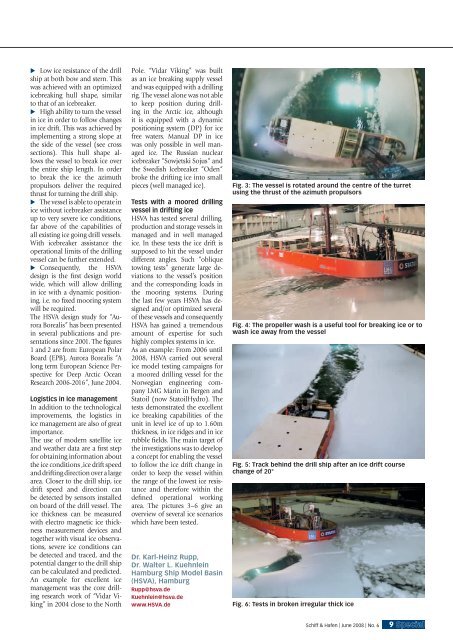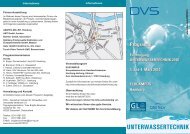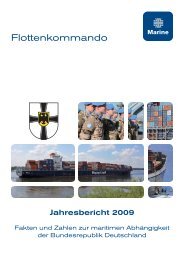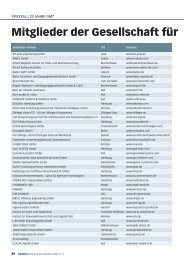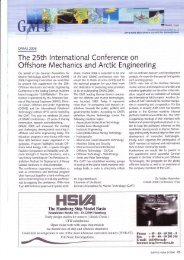Offshore Technology
Offshore Technology
Offshore Technology
Create successful ePaper yourself
Turn your PDF publications into a flip-book with our unique Google optimized e-Paper software.
� Low ice resistance of the drill<br />
ship at both bow and stern. This<br />
was achieved with an optimized<br />
icebreaking hull shape, similar<br />
to that of an icebreaker.<br />
� High ability to turn the vessel<br />
in ice in order to follow changes<br />
in ice drift. This was achieved by<br />
implementing a strong slope at<br />
the side of the vessel (see cross<br />
sections). This hull shape allows<br />
the vessel to break ice over<br />
the entire ship length. In order<br />
to break the ice the azimuth<br />
propulsors deliver the required<br />
thrust for turning the drill ship.<br />
� The vessel is able to operate in<br />
ice without icebreaker assistance<br />
up to very severe ice conditions,<br />
far above of the capabilities of<br />
all existing ice going drill vessels.<br />
With icebreaker assistance the<br />
operational limits of the drilling<br />
vessel can be further extended.<br />
� Consequently, the HSVA<br />
design is the fi rst design world<br />
wide, which will allow drilling<br />
in ice with a dynamic positioning,<br />
i.e. no fi xed mooring system<br />
will be required.<br />
The HSVA design study for “Aurora<br />
Borealis” has been presented<br />
in several publications and presentations<br />
since 2001. The fi gures<br />
1 and 2 are from: European Polar<br />
Board (EPB), Aurora Borealis “A<br />
long term European Science Perspective<br />
for Deep Arctic Ocean<br />
Research 2006-2016”, June 2004.<br />
Logistics in ice management<br />
In addition to the technological<br />
improvements, the logistics in<br />
ice management are also of great<br />
importance.<br />
The use of modern satellite ice<br />
and weather data are a fi rst step<br />
for obtaining information about<br />
the ice conditions ,ice drift speed<br />
and drifting direction over a large<br />
area. Closer to the drill ship, ice<br />
drift speed and direction can<br />
be detected by sensors installed<br />
on board of the drill vessel. The<br />
ice thickness can be measured<br />
with electro magnetic ice thickness<br />
measurement devices and<br />
together with visual ice observations,<br />
severe ice conditions can<br />
be detected and traced, and the<br />
potential danger to the drill ship<br />
can be calculated and predicted.<br />
An example for excellent ice<br />
management was the core drilling<br />
research work of “Vidar Viking”<br />
in 2004 close to the North<br />
Pole. “Vidar Viking” was built<br />
as an ice breaking supply vessel<br />
and was equipped with a drilling<br />
rig. The vessel alone was not able<br />
to keep position during drilling<br />
in the Arctic ice, although<br />
it is equipped with a dynamic<br />
positioning system (DP) for ice<br />
free waters. Manual DP in ice<br />
was only possible in well managed<br />
ice. The Russian nuclear<br />
icebreaker “Sowjetski Sojus“ and<br />
the Swedish Icebreaker “Oden“<br />
broke the drifting ice into small<br />
pieces (well managed ice).<br />
Tests with a moored drilling<br />
vessel in drifting ice<br />
HSVA has tested several drilling,<br />
production and storage vessels in<br />
managed and in well managed<br />
ice. In these tests the ice drift is<br />
supposed to hit the vessel under<br />
different angles. Such “oblique<br />
towing tests” generate large deviations<br />
to the vessel’s position<br />
and the corresponding loads in<br />
the mooring systems. During<br />
the last few years HSVA has designed<br />
and/or optimized several<br />
of these vessels and consequently<br />
HSVA has gained a tremendous<br />
amount of expertise for such<br />
highly complex systems in ice.<br />
As an example: From 2006 until<br />
2008, HSVA carried out several<br />
ice model testing campaigns for<br />
a moored drilling vessel for the<br />
Norwegian engineering company<br />
LMG Marin in Bergen and<br />
Statoil (now StatoilHydro). The<br />
tests demonstrated the excellent<br />
ice breaking capabilities of the<br />
unit in level ice of up to 1.60m<br />
thickness, in ice ridges and in ice<br />
rubble fi elds. The main target of<br />
the investigations was to develop<br />
a concept for enabling the vessel<br />
to follow the ice drift change in<br />
order to keep the vessel within<br />
the range of the lowest ice resistance<br />
and therefore within the<br />
defi ned operational working<br />
area. The pictures 3–6 give an<br />
overview of several ice scenarios<br />
which have been tested.<br />
Dr. Karl-Heinz Rupp,<br />
Dr. Walter L. Kuehnlein<br />
Hamburg Ship Model Basin<br />
(HSVA), Hamburg<br />
Rupp@hsva.de<br />
Kuehnlein@hsva.de<br />
www.HSVA.de<br />
Fig. 3: The vessel is rotated around the centre of the turret<br />
using the thrust of the azimuth propulsors<br />
Fig. 4: The propeller wash is a useful tool for breaking ice or to<br />
wash ice away from the vessel<br />
Fig. 5: Track behind the drill ship after an ice drift course<br />
change of 20°<br />
Fig. 6: Tests in broken irregular thick ice<br />
Schiff & Hafen | June 2008 | No. 6 9 Special


